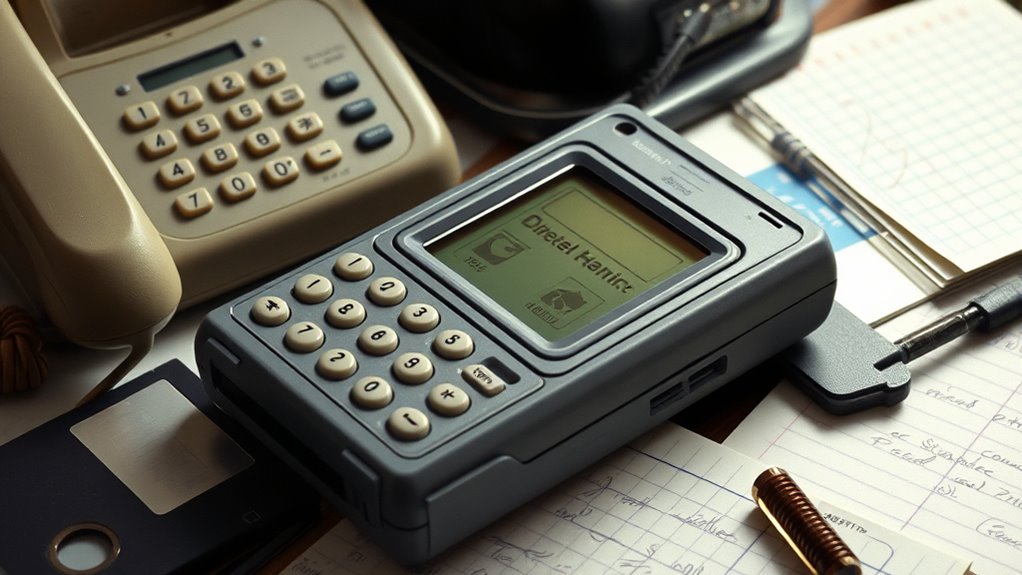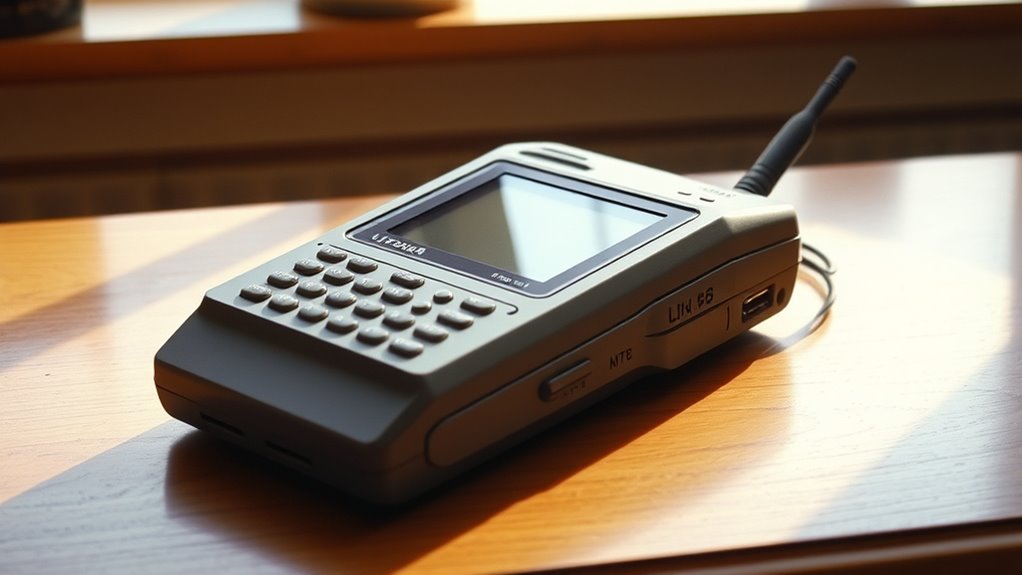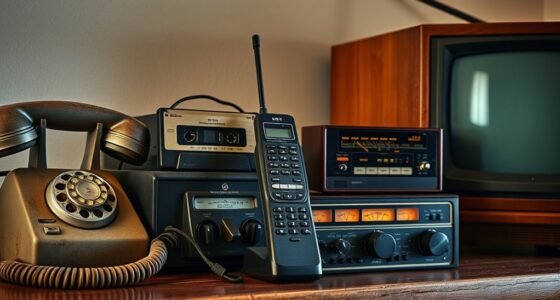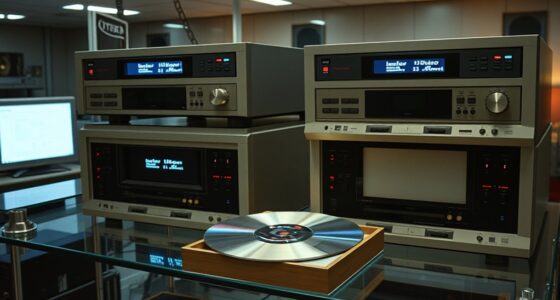In 1992, smartphones really got their start with the IBM Simon Personal Communicator, a device that combined phone functions and PDA features into one. You could make calls, send faxes, manage contacts, and organize your schedule all from a touchscreen interface. Despite hardware limitations, it set the stage for future smartphones. If you want to learn how this early device influenced today’s technology, there’s more to uncover below.
Key Takeaways
- The IBM Simon Personal Communicator in 1992 was the first device combining phone and PDA functionalities.
- It featured a touchscreen interface, allowing users to make calls and manage contacts and appointments.
- Despite hardware limitations, it integrated data management and communication features innovatively.
- Early mobile operating systems supported basic tasks, paving the way for more advanced platforms later.
- The IBM Simon’s hybrid design marked the beginning of the smartphone evolution, influencing future device development.

Back in 1992, the concept of a smartphone took its first step when engineers created a phone-PDA mashup that combined communication with personal organization. This device, called the IBM Simon Personal Communicator, was groundbreaking because it introduced features that are now standard in smartphones. It wasn’t just a phone; it was an early mobile device that integrated a touchscreen, basic applications, and data management. At that time, mobile hardware was limited compared to today’s standards, but it was innovative enough to set the stage for future development. You could make calls, send faxes, and even manage contacts and appointments from a single device, which was revolutionary. The development of high refresh rates in displays also contributed to smoother user interactions on subsequent devices.
In 1992, the IBM Simon combined calls, faxes, contacts, and appointments in a groundbreaking phone-PDA hybrid.
The evolution of these early mobile devices was closely tied to the development of mobile operating systems. The IBM Simon ran on a proprietary OS designed specifically for its hardware, which meant it could handle basic tasks but lacked the versatility of modern systems. As technology progressed, newer mobile hardware became more capable, allowing for more sophisticated operating systems to emerge. These systems, like Nokia’s Symbian and later Windows Mobile, provided a more flexible platform for developers, enabling a wider range of applications and better user interfaces. You can imagine how exciting it was at the time to see these devices grow more powerful and easier to use.
Early mobile hardware was characterized by small screens, bulky batteries, and limited processing power. Despite these limitations, engineers managed to pack a surprising amount of functionality into these early devices. They used resistive touchscreens that responded to stylus input rather than finger gestures, and the hardware was often bulky and heavy by today’s standards. Yet, these devices laid the foundation for what would become the modern smartphone. As hardware improved, so did the capabilities of mobile operating systems, allowing for multitasking, better graphics, and more intuitive interfaces. This constant innovation pushed the industry forward, making smartphones more accessible and powerful with each generation.
Today, it’s easy to forget that the first smartphones were clunky, basic devices that only hinted at their future potential. The early mobile hardware and specialized operating systems were essential in this evolution, providing the tools and platforms needed to develop the feature-rich smartphones we rely on today. You now hold a device that’s a far cry from the bulky, limited gadgets of the early 90s, but understanding their origins helps you appreciate how far mobile technology has come. These pioneering devices sparked a revolution that transformed communication, personal organization, and even how you connect with the world every day.
Frequently Asked Questions
How Did Early Smartphone Devices Influence Modern Mobile App Development?
You see, early smartphones laid the groundwork for modern mobile app development by shaping mobile app ecosystems and emphasizing user interface design. They introduced the idea of integrating multiple functions into one device, encouraging developers to create versatile apps. This focus on seamless user experience and ecosystem growth influenced today’s app stores and design standards, making your smartphone more intuitive and versatile than ever.
What Were the Primary Challenges Faced During the First Smartphone Designs?
You faced major challenges during early smartphone designs, from battery limitations that restricted usage time to user interface issues that made devices hard to navigate. You struggled to balance power and portability, making batteries last longer without adding bulk. You also worked to simplify interfaces so users could easily access features. These obstacles pushed you to innovate, shaping the smartphones we rely on today.
How Did Consumer Reception Impact the Evolution of Smartphones in the 1990S?
You see, consumer reception played a vital role in shaping the evolution of 1990s smartphones. When users embraced features like portability and integrated functions, manufacturers responded by improving design, battery life, and usability. Market acceptance, driven by positive user feedback, encouraged innovation and increased adoption. Conversely, poor reception or unmet expectations led companies to refine their devices, ultimately pushing smartphones toward more sophisticated, user-friendly models that set the stage for future advancements.
Which Companies Were Pioneers in Developing Early Smartphone Technology?
Prepare to be amazed, because pioneering companies like IBM and Nokia led the charge as early innovators in smartphone technology. They developed groundbreaking devices that combined phone and PDA features, transforming mobile communication. These trailblazers laid the foundation for modern smartphones, pushing boundaries and sparking consumer interest. By integrating innovative tech, these companies changed how we connect, making them true pioneers in the evolution of mobile devices.
What Technological Innovations Enabled the Transition From PDAS to Smartphones?
To shift from PDAs to smartphones, you benefited from key technological innovations like wireless connectivity, allowing seamless internet access and communication. Touchscreen interfaces replaced physical buttons, making devices more user-friendly and versatile. These advancements enabled phones to combine PDA features with phone capabilities, creating a new category of mobile devices. The integration of wireless tech and intuitive touchscreens revolutionized your mobile experience, paving the way for modern smartphones.
Conclusion
Think of those early smartphones as the seeds of a mighty tree, planted in 1992, growing into the towering tech giants we rely on today. From that simple mashup of phone and PDA, you’ve watched innovation blossom into devices that connect, organize, and empower you every day. Just as a small spark ignites a blazing fire, those first steps sparked a revolution, transforming your pocket into a gateway to the world.









